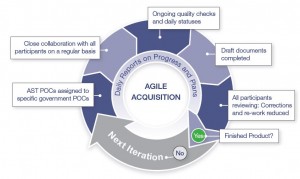
Increasingly in today’s economic climate, Agile methodologies are the answer to the Government’s constant search for ways to do more with less.
In its July 2012 report, “Effective Practices and Federal Challenges in Applying Agile Methods,” the Government Accountability Office (GAO) recognized that a growing number of federal agencies are using Agile techniques to develop and purchase software. The use of Agile can also be very beneficial when used in acquisition support. This effective methodology, aligned with best practices in a host of project management activities, capitalize on flexibility and speed to deliver needed solutions while reducing investment risk – the ideal solution for today’s most pressing issues in Government acquisition.
So how do Agile methodologies manage to accomplish this? What is the recipe for success that has allowed them to rise to the top as a preferred method in the Government contracting industry? And how, in particular, can we apply the Agile method to cradle-to-grave acquisition support? This blog post will identify what Agile Acquisition Support is and who the participants are, before describing how Agile Acquisition Support works. Next time in Part II, I will go beyond these basics to outline the specific benefits of this methodology for little “a” acquisition support.
What is Agile Acquisition Support?
Agile Acquisition support uses Agile methodologies in federal requiring activities, acquisition management teams and contracting activities during any stage of the acquisition life cycle. It allows teams to identify and quickly address potential hurdles early in the acquisition life cycle while providing working templates, lessons learned and repeatable procedures. A much more organized and thorough approach, Agile methodology in Acquisition mitigates most possible pitfalls. Because it is not dependent on IT Agile acquisition methodologies, it can be used for simple acquisitions (from the smallest product purchases) to very large acquisitions (purchasing major systems).
Who Participates In and Facilitates Agile Methodology?
Unlike a traditional non-Agile acquisition team (with only few points of contact and limited knowledge-sharing), an Agile Acquisition Support Team (AST) will encounter and work with a number of participants and stakeholders. When combined, these diverse and numerous participants have ample knowledge that assists in preparing a complete procurement package that will fully meet the Government’s requirements upon award. The key players in the Agile framework are:
- Requiring activity
- Functional and/or technical teams
- Acquisition management staff
- End users
- Contracting activity
- AST
Requiring Activity: The Requiring Activity identifies, analyzes, develops and approves requirements to properly request acquisition and contracting support. It consists of Program Directors, Program Analysts and Contracting Officer Representatives (CORs). End users and functional and technical teams may also participate in this activity.
Functional and Technical Teams: The Functional Team understands the functionality of a particular software, system or product. It works with the Technical team to make the functional capabilities come to life through technology use.
Acquisition Management Staff: This team consists of Government personnel who make acquisition decisions for an agency. (For smaller acquisitions, this can be one individual.)
End Users: The end users best understand what is needed for full operability or usability of products and services; they actually use or interface with the software, system or product.
Contracting Activity: This group consists of Contracting Officers, Contract Specialists and other support who review procurement packages, prepare necessary paperwork to post Requests for Information (RFIs), solicit contract holders and amend solicitations. They also execute contract awards, execute unilateral and bilateral modifications, extend contracts and exercise option periods.
Acquisition Support Team: This team (which can be contractor personnel, Government personnel or a combination of both) assists with requirements development, acquisition planning, source selection boards and contract close-outs, while preparing procurement and modification packages. The AST collaborates with all participants and provides daily updates.
How Does Agile Acquisition Support Work?
Daily scrums provide the important opportunity for the management team to receive updates from team members on progress, while facilitating close collaboration between participants and stakeholders. A scrum is a short meeting at which participants discuss recent accomplishments, future goals and potential obstacles. Every team member is responsible for a daily log so management remains aware of all team members’ actions and statuses, facilitating full team member accountability. This tracking of activities prevents duplication of effort and promotes the sharing of lessons learned.
Overall, Agile Acquisition Support provides an efficient, effective methodology by:
- Increasing communication and collaboration among multiple contracting personnel to promote knowledge-sharing for all components of the acquisition process
- Producing templates, lessons learned and repeatable procedures that save the Government both time and money in making processes more efficient
- Promoting team member accountability at scrums for updating management on project statuses, accomplishments, goals and potential obstacles
In Part II, I will describe in more detail how the Agile framework can bring particular benefits to little “a” acquisition. See the Integrity Knowledge Center to download my full article on the topic, and how my team is implementing Agile Acquisition Support for a Federal agency.
Related Article: Agile Acquisition Support – Real-World Considerations

